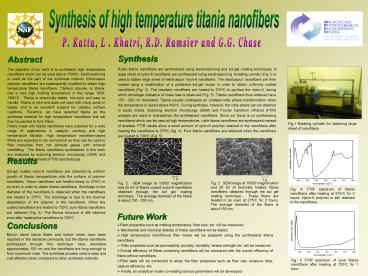Synthesis PowerPoint PPT Presentation
1 / 1
Title: Synthesis
1
Synthesis of high temperature titania nanofibers
P. Katta, L . Khatri, R.D. Ramsier and G.G. Chase
Synthesis Rutile titania nanofibers are
synthesized using electrospinning and sol-gel
coating techniques. A large sheet of nylon-6
nanofibers are synthesized using electrospinning.
Rotating cylinder (Fig.1) is used to obtain large
sheet of electrospun nylon-6 nanofibers. The
electrospun nanofibers are then coated using a
modification of a published sol-gel recipe in
order to obtain uniformly coated nanofibers (Fig.
2). The resultant nanofibers are heated to 275oC
to pyrolize the nylon-6, during which shrinkage
indicative of mass loss is observed (Fig. 3).
Titania nanofibers thus obtained have 150 - 200
nm diameters. Titania usually undergoes an
anatase-rutile phase transformation when the
temperature is raised above 450oC. During
synthesis, however, the rutile phase can be
obtained in acidic media. Scanning electron
microscopy (SEM) and Fourier transform infrared
(FTIR) analysis are used to characterize the
synthesized nanofibers. Since our focus is on
synthesizing nanofibers which can be used at high
temperatures, rutile titania nanofibers are
synthesized instead of anatase. FTIR results show
a small amount of nylon-6 polymer retained in the
nanofibers after heating the nanofibers to 275oC
(fig. 4). Pure titania nanofibers are obtained
when the nanofibers are heated to 700oC (Fig. 5).
Abstract The objective of our work is to
synthesize high temperature nanofibers which can
be used above 1500oC. Electrospinning is used as
the part of the synthesis method. Electrospun
polymer nanofibers are subsequently modified to
obtain high temperature titania nanofibers.
Titanium dioxide, or titania, has a very high
melting temperature in the range 1830-1850C.
Titania is chemically stable, non-toxic and easy
to handle. Titania is inert and does not react
with many acids or bases, and is an excellent
support for catalytic surface reactions.
Therefore, we have selected titania as the
synthesis material for high temperature
nanofibers that will then be packed to form
filters. Filters made with titania nanofibers
have potential for a wide range of applications
in catalytic cracking and high temperature
filtration. High temperature nanofiber-based
filters are expected to be economical as they can
be used to filter impurities from hot exhaust
gases with minimal retrofitting. The titania
nanofibers synthesized in this work are analyzed
by scanning electron microscopy (SEM) and fourier
transform infrared (FTIR) spectroscopy.
Results Sol-gel coated nylon-6 nanofibers are
obtained by uniform growth of titania
nanoparticles onto the surface of polymer
nanofibers. These nanofibers are heated slowly to
275oC in an oven in order to obtain titania
nanofibers. Shrinkage in the diameter of the
nanofibers is observed when the nanofibers are
heated to 275oC. The shrinkage is due to the
thermal degradation of the polymer in the
nanofibers. When the coated nanofibers are heated
to 700oC pure titania nanofibers are obtained
(Fig. 5). The fibrous structure is still retained
even after heating the nanofibers to 700oC.
- Future Work
- Fiber properties such as melting temperature,
fiber size, etc. will be measured. - Mechanical and chemical stability of these
nanofibers will be tested. - High temperature nanofibrous filter media will
be prepared using the synthesized titania
nanofibers. - Filter properties such as permeability,
porosity, durability, tensile strength etc. will
be measured. - Overall efficiency of filters containing
nanofibers will be compared with the overall
efficiency of filters without nanofibers. - Filter tests will be conducted to study the
filter properties such as flow rate, pressure
drop, capture efficiency, etc. - Finally, an analytical model correlating various
parameters will be developed.
Conclusions Micron sized titania fibers and
hollow tubes have been reported in the literature
previously, but the titania nanofibers
synthesized through this technique have diameters
approximately 150 nm and the nanofibers are long
enough to form nonwoven mats. The synthesis
process used is easy and cost effective when
compared to other synthesis methods.

